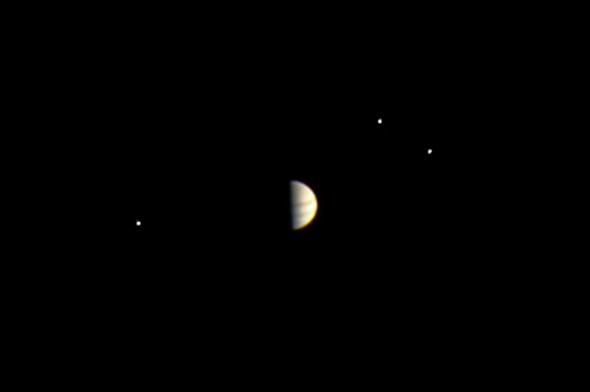Create a free profile to get unlimited access to exclusive videos, sweepstakes, and more!
Follow-Up: Jupiter’s Moons Dance as Juno Approached

Monday night, for the first time in nearly two decades, humanity added a new moon to Jupiter: The spacecraft Juno successfully entered orbit around the giant planet, beginning a nearly two-year-long mission to study Jupiter’s interior and determine its origin story.
You can read all about that in my post from early Tuesday morning. Too late for me to include it, though, NASA released a nifty video showing Juno’s view of Jupiter and its four large moons as it approached the system. It’s really quite entrancing:
It’s slow at first, but you can see the disk of Jupiter swell as Juno got closer, from 16 million kilometers distant on June 12 to only about 5 million kilometers on June 29. Juno approached “from the side and above,” if you will; in other words instead of heading straight out to Jupiter it was on a path that took it on a long, curving trajectory that had it sidling up to the huge world. That’s why Jupiter is half lit; the Sun is off to the right, nearly 800 million km away.
It also approached from above Jupiter’s orbital plane, so we’re looking down on the moons, and can see their nearly circular orbits as ellipses (like the lip of a drinking glass looking oval shaped when seen from an angle). Over the 19 days of the animation the moons move, and you can see which is which by how fast each moves: Io takes 1.8 days to circle Jupiter, Europa 3.6, Ganymede 7.2, and Callisto 16.7.
A few things to note in the animation that are cool: One is that you can see Io, Ganymede, and Europa disappear as they enter Jupiter’s shadow on the left. They seemingly flick out of existence briefly as they are eclipsed by the gigantic planet, which blocks the Sun’s light. This can sometimes be seen from Earth, but due to the geometry (Jupiter is farther out from the Sun than Earth) the eclipses appear to happen very near the disk of the planet itself, like we’re peeking around the edge. Because Juno approached Jupiter from the side, the eclipses are obvious and easily seen well away from the planet. Amazing.
You may have noticed that Callisto flickers and jumps a bit as it moves. This isn’t real. As Emily Lakdawalla explains, it has to do with the optics of the JunoCam that was used to take these images. It wasn’t designed to see very tiny point sources of light, so as the image of Callisto fell between pixels it appears to flicker.
Finally, as Jupiter grows, you can start to see features on it, like the light zones and dark belts so familiar to anyone who has peered at the planet through a telescope. Juno will practically skim the cloud tops of Jupiter over its mission, taking incredible images of the dynamic and chaotic cloud structures. That will be breathtaking.
We won’t see those for a while though, since the spacecraft will be doing a thorough shakedown over the next few weeks. But stay tuned. We’re about to see Jupiter in a whole new way, and, hopefully, learn how it got to be what it is today.


























